The Master As I Saw Him
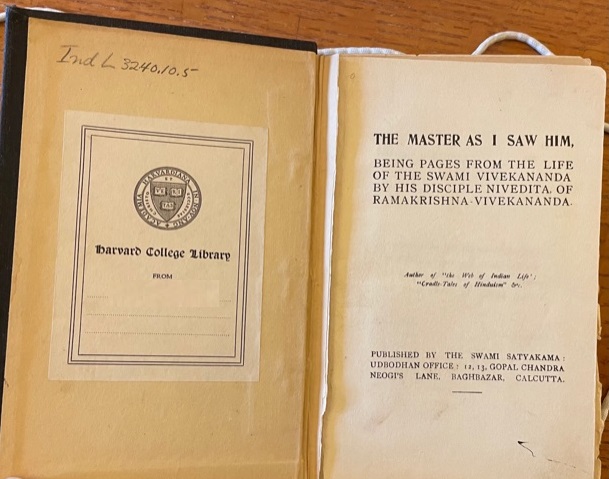
Being Pages From the Life of the Swami Vivekananda by his disciple Nivedita of Ramakrishna Vivekananda.

I
IN LONDON, 1895

XXIV – The Swami’s Teaching About Death
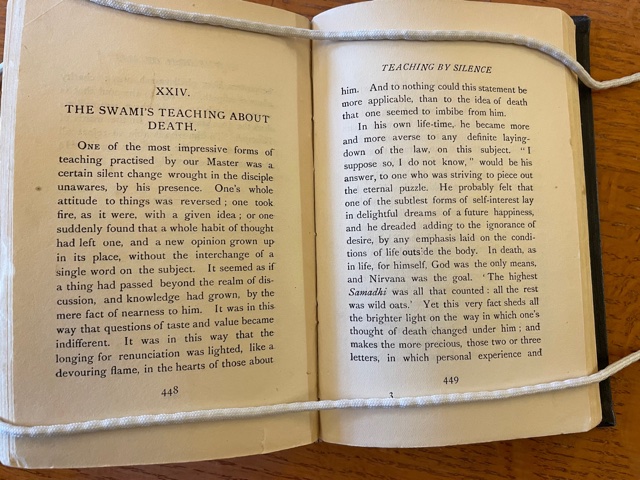
ONE of the most impressive forms of teaching practised by our Master was a certain silent change wrought in the disciple unawares, by his presence. One’s whole attitude to things was reversed; one took fire, as it were, with a given idea; or one suddenly found that a whole habit of thought had left one, and a new opinion grown up in its place, without the interchange of a single word on the subject.
It seemed as if a thing had passed beyond the realm of discussion, and knowledge had grown, by the mere fact of nearness to him. It was in this way that questions of taste and value became indifferent. It was in this way that the longing for renunciation was lighted, like a devouring flame, in the hearts of those about him. And to nothing could this statement be more applicable, than to the idea of death that one seemed to imbibe from him.
In his own life-time, he became more and more averse to any definite laying-down of the law, on this subject. “I suppose so, I do not know,” would be his answer, to one who was striving to piece out the eternal puzzle. He probably felt that one of the subtlest forms of self-interest lay in delightful dreams of a future happiness, and he dreaded adding to the ignorance of desire, by any emphasis laid on the conditions of life outside the body.
In death, as in life, for himself, God was the only means, and Nirvana was the goal. ‘The highest Samadhi was all that counted: all the rest was wild oats.’ Yet this very fact sheds all the brighter light on the way in which one’s thought of death changed under him; and makes the more precious, those two or three letters, in which personal experience and
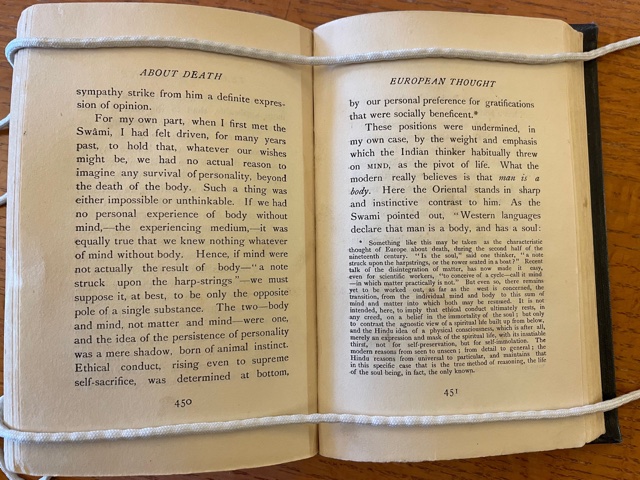
sympathy strike from him a definite expression of opinion.
For my own part, when I first met the Swami, I had felt driven, for many years past, to hold that, whatever our wishes might be, we had no actual reason to imagine any survival of personality, beyond the death of the body. Such a thing was either impossible or unthinkable. If we had no personal experience of body without mind, – the experiencing medium, – it was equally true that we knew nothing whatever of mind without body. Hence, if mind were not actually the result of body – “a note struck upon the harp-strings” – we must suppose it, at best, to be only the opposite pole of a single substance. The two – body and mind, not matter and mind – were one, and the idea of the persistence of personality was a mere shadow, born of animal instinct. Ethical conduct, rising even to supreme self-sacrifice, was determined at bottom, by our personal preference for gratifications that were socially beneficent.*
These positions were undermined, in my own case, by the weight and emphasis which the Indian thinker habitually threw on MIND, as the pivot of life. What the modern really believes is that man is a body. Here the Oriental stands in sharp and instinctive contrast to him. As the Swami pointed out, “Western languages declare that man is a body, and has a soul:
* Something like this may be taken as the characteristic thought of Europe about death, during the second half of the nineteenth century. “Is the soul,” said one thinker, “a note struck upon the harpstrings, or the rower seated in a boat?”
Recent talk of the disintegration of matter has now made it easy, even for scientific workers, “to conceive of a cycle – call it mind – in which matter practically is not.” But even so, there remains yet to be worked out, as far as the west is concerned, the transition, from the individual mind and body to this sum of mind and matter into which both may be resumed.
It is not intended, here, to imply that ethical conduct ultimately rests, in any creed, on a belief in the immortality of the soul; but only to contrast the agnostic view of a spiritual life built up from below, and the Hindu idea of a physical consciousness, which is after all, merely an expression and mask of the spiritual life, with its insatiable thirst, not for self-preservation, but for self-immolation. The modern reasons from seen to unseen; from detail to general; the Hindu reasons from universal to particular, and maintains that in this specific case that is the true method of reasoning, the life of the soul being, in fact, the only known.
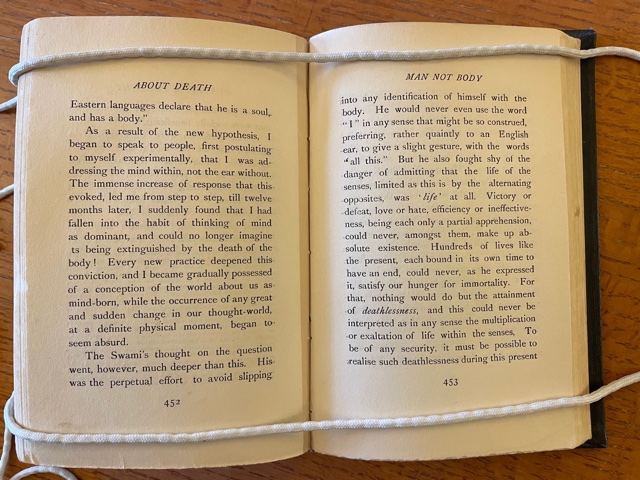
Eastern languages declare that he is a soul, and has a body.”
As a result of the new hypothesis, I began to speak to people, first postulating to myself experimentally, that I was addressing the mind within, not the ear without. The immense increase of response that this evoked, led me from step to step, till twelve months later, I suddenly found that I had fallen into the habit of thinking of mind as dominant, and could no longer imagine its being extinguished by the death of the body! Every new practice deepened this conviction, and I became gradually possessed of a conception of the world about us as mind-born, while the occurrence of any great and sudden change in our thought-world, at a definite physical moment, began to seem absurd.
The Swami’s thought on the question went, however, much deeper than this. His was the perpetual effort to avoid slipping into any identification of himself with the body. He would never even use the word “I” in any sense that might be so construed, preferring, rather quaintly to an English ear, to give a slight gesture, with the words ”all this.” But he also fought shy of the danger of admitting that the life of the senses, limited as this is by the alternating opposites, was ‘life’ at all. Victory or defeat, love or hate, efficiency or ineffectiveness, being each only a partial apprehension, could never, amongst them, make up absolute existence. Hundreds of lives like the present, each bound in its own time to have an end, could never, as he expressed it, satisfy our hunger for immortality. For that, nothing would do but the attainment of deathlessness, and this could never be interpreted as in any sense the multiplication or exaltation of life within the senses. To be of any security, it must be possible to realise such deathlessness during this present
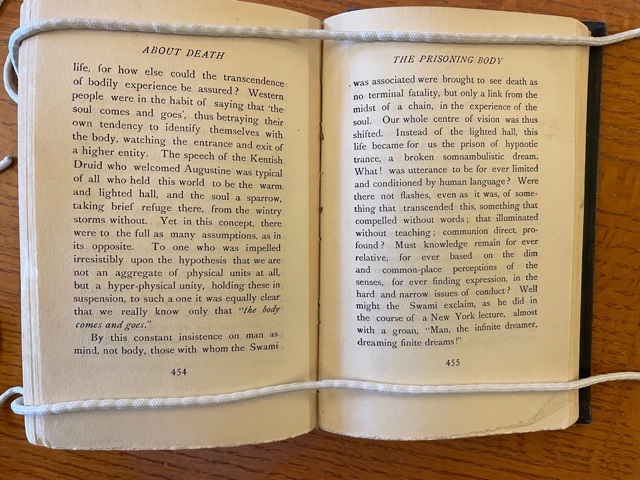
life, for how else could the transcendence of bodily experience be assured?
Western people were in the habit of saying that ‘the soul comes and goes’, thus betraying their own tendency to identify themselves with the body, watching the entrance and exit of a higher entity. The speech of the Kentish Druid who welcomed Augustine was typical of all who held this world to be the warm and lighted hall, and the soul a sparrow, taking brief refuge there, from the wintry storms without.
Yet in this concept, there were to the full as many assumptions, as in its opposite. To one who was impelled irresistibly upon the hypothesis that we are not an aggregate of physical units at all, but a hyper-physical unity, holding these in suspension, to such a one it was equally clear that we really know only that “the body comes and goes.”
By this constant insistence on man as mind, not body, those with whom the Swami was associated were brought to see death as no terminal fatality, but only a link from the midst of a chain, in the experience of the soul. Our whole centre of vision was thus shifted. Instead of the lighted hall, this life became for us the prison of hypnotic trance, a broken somnambulistic dream.
What! was utterance to be for ever limited and conditioned by human language? Were there not flashes, even as it was, of something that transcended this, something that compelled without words; that illuminated without teaching; communion direct, profound? Must knowledge remain for ever relative, for ever based on the dim and common-place perceptions of the senses, for ever finding expression, in the hard and narrow issues of conduct? Well might the Swami exclaim, as he did in the course of a New York lecture, almost with a groan, “Man, the infinite dreamer, dreaming finite dreams!”

By his scorn of such, by his own passionate longing to wander off, silent and nude, along the banks of the Ganges, by his constant turning to the super-conscious as the only content of consciousness to be desired, by his personal attitude to the relationships of life as so many fetters and impedimenta to the freedom of the soul, Vivekananda built up in those about him some sort of measure of Real Existence, and the idea that the mere fall of the body could seriously interrupt this, became impossible.
We were saturated with the thought that the accessories of life were but so many externals of a passing dream, and it seemed obvious that we should go onwards, after death, much as we were doing before it, with only such added intensity and speed as might be due to the subtler medium in which we should find ourselves. It seemed obvious too, that, as he declared, an eternal heaven or hell, based on the deeds of this present life, was an absurdity, since a finite cause could not, by any means, have an infinite effect.
Yet the Swami laid down no hard and fast conclusions on these subjects, for others to accept. He carried those about him at any given time, as far as they could go, by the force of his own vision, by the energy of his effort to express in words the thing he himself saw. But he would have nothing to do with dogma, and he was exceedingly averse to making promises about the future. As already said, “I do not know” became more and more his answer, as years went on to questions about the fate of the soul in death. Each one, to his thinking, must work out his own belief, basing it on the data of his own experience. Nothing that he should say must ever interfere with the free growth of personal conviction.
Some things, however, were noticeable. He appeared to share the common assump-
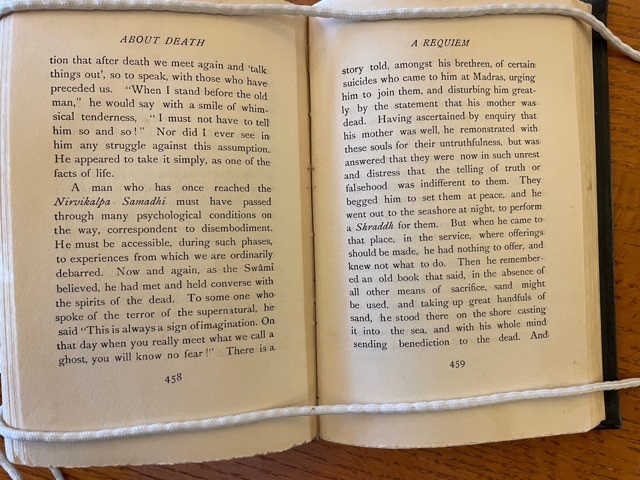
tion that after death we meet again and ‘talk things out’, so to speak, with those who have preceded us. “When I stand before the old man,” he would say with a smile of whimsical tenderness, “I must not have to tell him so and so!” Nor did I ever see in him any struggle against this assumption. He appeared to take it simply, as one of the facts of life.
A man who has once reached the Nirvikalpa Samadhi must have passed through many psychological conditions on the way, correspondent to disembodiment. He must be accessible, during such phases, to experiences from which we are ordinarily debarred.
Now and again, as the Swami believed, he had met and held converse with the spirits of the dead. To someone who spoke of the terror of the supernatural, he said “This is always a sign of imagination. On that day when you really meet what we call a ghost, you will know no fear!”
There is a story told, amongst his brethren, of certain suicides who came to him at Madras, urging him to join them, and disturbing him greatly by the statement that his mother was dead. Having ascertained by enquiry that his mother was well, he remonstrated with these souls for their untruthfulness, but was answered that they were now in such unrest and distress that the telling of truth or falsehood was indifferent to them.
They begged him to set them at peace, and he went out to the seashore at night, to perform a Shraddh for them. But when he came to that place, in the service, where offerings should be made, he had nothing to offer, and knew not what to do. Then he remembered an old book that said, in the absence of all other means of sacrifice, sand might be used, and taking up great handfuls of sand, he stood there on the shore casting it into the sea, and with his whole mind sending benediction to the dead. And
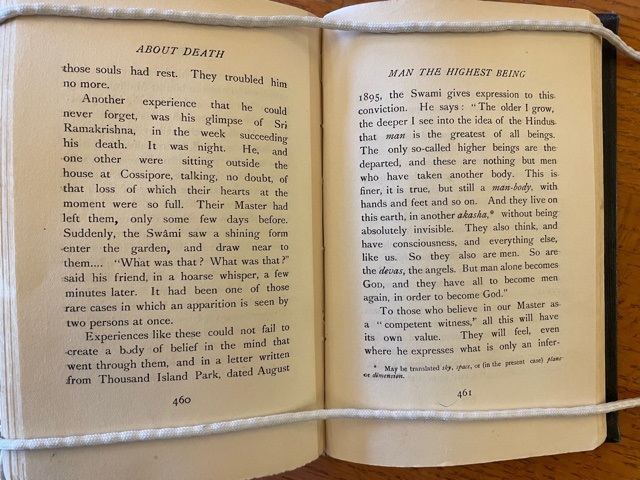
those souls had rest. They troubled him no more.
Another experience that he could never forget, was his glimpse of Sri Ramakrishna, in the week succeeding his death. It was night. He, and one other were sitting outside the house at Cossipore, talking, no doubt, of that loss of which their hearts at the moment were so full. Their Master had left them, only some few days before. Suddenly, the Swami saw a shining form enter the garden, and draw near to them…. “What was that? What was that?” said his friend, in a hoarse whisper, a few minutes later. It had been one of those rare cases in which an apparition is seen by two persons at once.
Experiences like these could not fail to create a body of belief in the mind that went through them, and in a letter written from Thousand Island Park, dated August 1895, the Swami gives expression to this conviction.
He says: “The older I grow, the deeper I see into the idea of the Hindus that man is the greatest of all beings. The only so-called higher beings are the departed, and these are nothing but men who have taken another body. This is finer, it is true, but still a man-body, with hands and feet and so on. And they live on this earth, in another akasha,* without being absolutely invisible. They also think, and have consciousness, and everything else, like us. So they also are men. So are the devas, the angels. But man alone becomes GOD, and they have all to become men again, in order to become God.”
To those who believe in our Master as a “competent witness,” all this will have its own value. They will feel, even where he expresses what is only an infer-
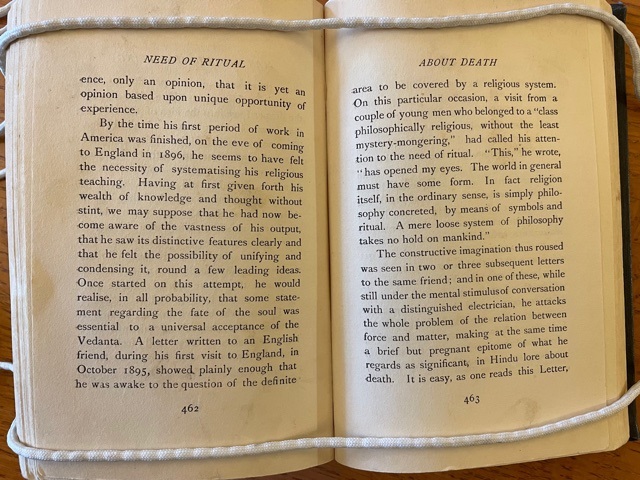
ence, only an opinion, that it is yet an opinion based upon unique opportunity of experience.
By the time his first period of work in America was finished, on the eve of coming to England in 1896, he seems to have felt the necessity of systematising his religious teaching. Having at first given forth his wealth of knowledge and thought without stint, we may suppose that he had now become aware of the vastness of his output, that he saw its distinctive features clearly and that he felt the possibility of unifying and condensing it, round a few leading ideas.
Once started on this attempt, he would realise, in all probability, that some statement regarding the fate of the soul was essential to a universal acceptance of the Vedanta. A letter written to an English friend, during his first visit to England, in October 1895, showed plainly enough that he was awake to the question of the definite-area to be covered by a religious system.
On this particular occasion, a visit from a couple of young men who belonged to a “class philosophically religious, without the least mystery-mongering,” had called his attention to the need of ritual. “This,” he wrote, “has opened my eyes. The world in general must have some form. In fact religion itself, in the ordinary sense, is simply philosophy concreted, by means of symbols and ritual. A mere loose system of philosophy takes no hold on mankind.”
The constructive imagination thus roused was seen in two or three subsequent letters to the same friend; and in one of these, while still under the mental stimulus of conversation with a distinguished electrician, he attacks the whole problem of the relation between force and matter, making at the same time a brief but pregnant epitome of what he regards as significant, in Hindu lore about death.
It is easy, as one reads this Letter,
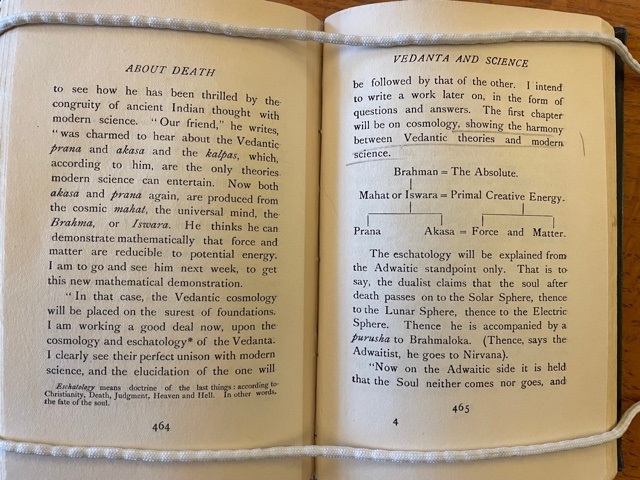
to see how he has been thrilled by the congruity of ancient Indian thought with modern science. “Our friend,” he writes, “was charmed to hear about the Vedantic prana and akasa and the kalpas, which, according to him, are the only theories modern science can entertain. Now both akasa and prana again, are produced from the cosmic mahat, the universal mind, the Brahma, or Iswara. He thinks he can demonstrate mathematically that force and matter are reducible to potential energy. I am to go and see him next week, to get this new mathematical demonstration. “
“In that case, the Vedantic cosmology will be placed on the surest of foundations. I am working a good deal now, upon the cosmology and eschatology* of the Vedanta. I clearly see their perfect unison with modern science, and the elucidation of the one will
** Eschatology means doctrine of the last things; according to Christianity, Death, Judgment, Heaven and Hell. In other words, the fate of the soul.
be followed by that of the other. I intend to write a work later on, in the form of questions and answers. The first chapter will be on cosmology, showing the harmony between Vedantic theories and modern science.
The eschatology will be explained from the Advaitic standpoint only. That is to say, the dualist claims that the soul after death passes on to the Solar Sphere, thence to the Lunar Sphere, thence to the Electric Sphere. Thence he is accompanied by a purusha to Brahmaloka. (Thence, says the Advaitist, he goes to Nirvana). “
“Now on the Advaitic side it is held that the Soul neither comes nor goes, and

that all these spheres or layers of the universe are only so many varying products of akasa and prana.
That is to say, the lowest or most condensed is the Solar Sphere, consisting of the visible universe; in which Prana appear as physical force, and akasa as sensible matter. The next is called the Lunar Sphere, which surrounds the Solar Sphere. This is not the moon at all, but the habitation of the gods, that is to say, Prana appears in it as psychic forces, and Akasa as Tanmatras, or fine particles. Beyond this is the Electric Sphere, that is to say, a condition in which the Prana is almost inseparable from Akasa, and you can hardly tell whether Electricity is force or matter.
Next is the Brahmaloka, where there is neither Prana nor Akasa, but both are merged into the Mind-stuff, the primal energy. And here – there being neither Prana nor Akasa – the jiva contemplates the whole universe as Samashti, or the sum-total of Mahat, or mind. This appears as a Purusha, an abstract universal Soul, yet not the Absolute, for still there is multiplicity. From this, the jiva finds at last that Unity which is the end.
Advaitism says that these are the visions which arise in succession before the jiva, who, himself, neither goes nor comes, and that in the same way this present vision has been projected. The projection (Shrishti) and dissolution must take place in the same order, only one means going backward and the other coming out.”
“Now as each individual can only see his own universe, that universe is created with his bondage, and goes away with his liberation, although it remains for others who are in bondage.
Now name and form constitute the universe. A wave in the ocean is a wave, only in so far as it is bound by name and form. If the wave subsides, it is the ocean, but that name-and-form has immediately vanished forever. So that the
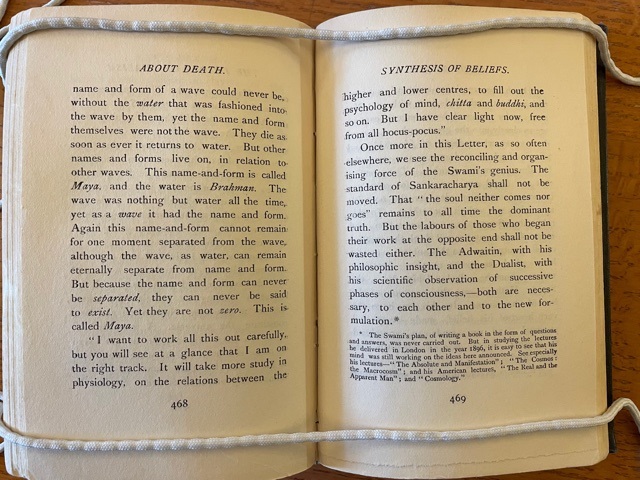
name
and form of a wave could never be, without the water that was fashioned into the wave by them, yet the name and form themselves were not the wave. They die as soon as ever it returns to water. But other names and forms live on, in relation to other waves. This name-and-form is called Maya, and the water is Brahman. The wave was nothing but water all the time, yet as a wave it had the name and form.
Again this name-and-form cannot remain for one moment separated from the wave, although the wave, as water, can remain eternally separate from name and form. But because the name and form can never be separated, they can never be said to exist. Yet they are not zero. This is called Maya.”
“I want to work all this out carefully, but you will see at a glance that I am on the right track. It will take more study in physiology, on the relations between the higher and lower centres, to fill out the psychology of mind, chitta and buddhi, and soon. But I have clear light now, free from all hocus-pocus.”
Once more in this Letter, as so often elsewhere, we see the reconciling and organising force of the Swami’s genius. The standard of Sankaracharya shall not be moved. That “the soul neither comes nor goes” remains to all time the dominant truth. But the labours of those who began their work at the opposite end shall not be wasted either. The Advaitin, with his philosophic insight, and the Dualist, with his scientific observation of successive phases of consciousness, – both are necessary, to each other and to the new formulation.*
* The Swami’s plan, of writing a book in the form of questions and answers, was never carried out. But in studying the lectures he delivered in London in the year 1896, it is easy to see that his mind was still working on the ideas here announced. See especially his lectures – “The Absolute and Manifestation”; “The Cosmos: the Macrocosm”; and his American lectures, “The Real and the Apparent Man”; and “Cosmology.”
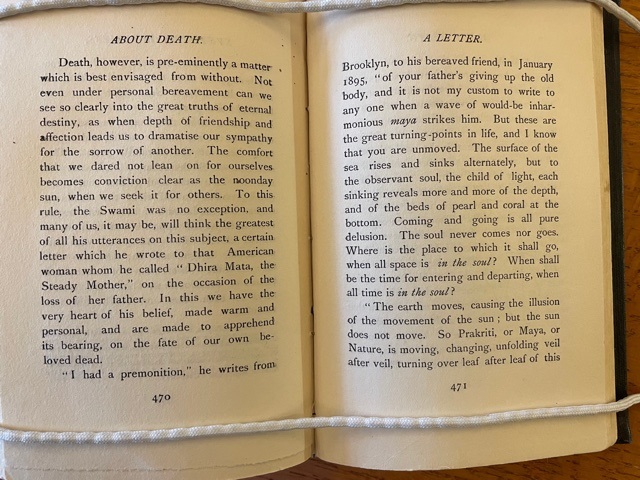
Death, however, is pre-eminently a matter which is best envisaged from without. Not even under personal bereavement can we see so clearly into the great truths of eternal destiny, as when depth of friendship and affection leads us to dramatise our sympathy for the sorrow of another. The comfort that we dared not lean on for ourselves becomes conviction clear as the noonday sun, when we seek it for others.
To this rule, the Swami was no exception, and many of us, it may be will think the greatest of all his utterances on this subject, a certain letter which he wrote to that American woman whom he called “Dhira Mata, the Steady Mother,” on the occasion of the loss of her father. In this we have the very heart of his belief, made warm and personal, and are made to apprehend its bearing, on the fate of our own beloved dead.
“I had a premonition,” he writes from Brooklyn, to his bereaved friend, in January 1895, “of your father’s giving up the old body, and it is not my custom to write to any one when a wave of would-be inharmonious maya strikes him. But these are the great turning-points in life, and I know that you are unmoved. The surface of the sea rises and sinks alternately, but to the observant soul, the child of light, each sinking reveals more and more of the depth, and of the beds of pearl and coral at the bottom. Coming and going is all pure delusion. The soul never comes nor goes. Where is the place to which it shall go, when all space is in the soul? When shall be the time for entering and departing, when all time is in the soul?”
“The earth moves, causing the illusion of the movement of the sun; but the sun does not move. So Prakriti, or Maya, or Nature, is moving, changing, unfolding veil after veil, turning over leaf after leaf of this
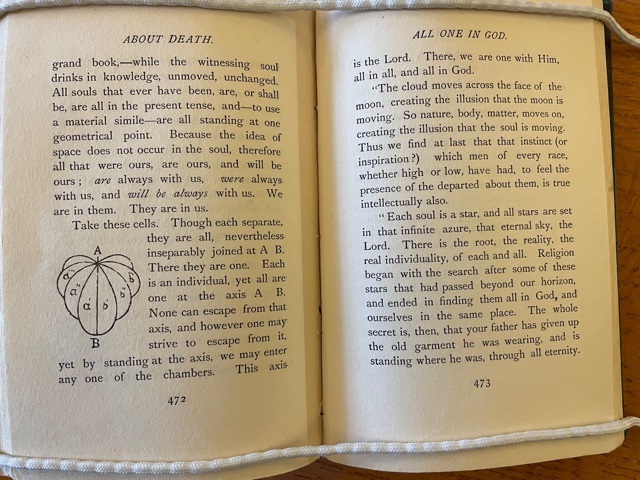
grand book, – while the witnessing soul drinks in knowledge, unmoved, unchanged.
All souls that ever have been, are, or shall be, are all in the present tense, and – to use a material simile – are all standing at one geometrical point. Because the idea of space does not occur in the soul, therefore all that were ours, are ours, and will be ours; are always with us, were always with us, and will be always with us. We are in them. They are in us.
“The cloud moves across the face of the moon, creating the illusion that the moon is moving. So nature, body, matter, moves on, creating the illusion that the soul is moving. Thus we find at last that that instinct (or inspiration?) which men of every race, whether high or low, have had, to feel the presence of the departed about them, is true intellectually also.”
“Each soul is a star, and all stars are set in that infinite azure, that eternal sky, the Lord. There is the root, the reality, the real individuality, of each and all. Religion began with the search after some of these stars that had passed beyond our horizon, and ended in finding them all in God, and ourselves in the same place. The whole secret is, then, that your father has given up the old garment he was wearing, and is standing where he was, through all eternity.
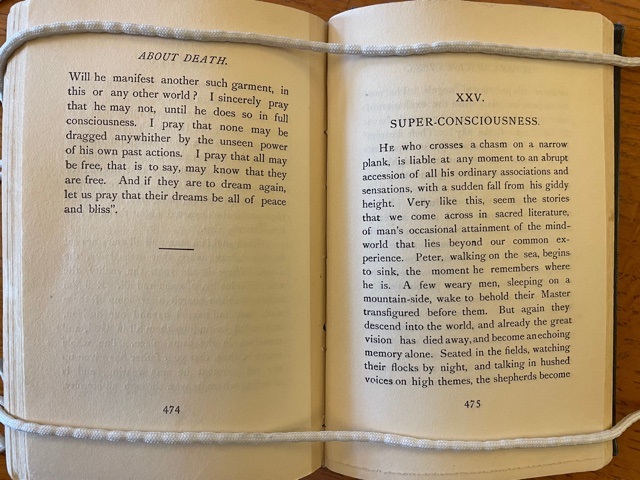
Will he manifest another such garment, in this or any other world? I sincerely pray that he may not, until he does so in full consciousness. I pray that none may be dragged anywhither by the unseen power of his own past actions. I pray that all may be free, that is to say, may know that they are free. And if they are to dream again, let us pray that their dreams be all of peace and bliss”.